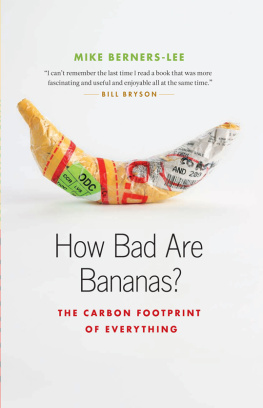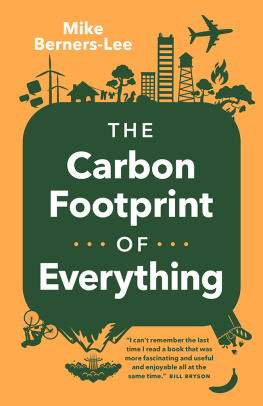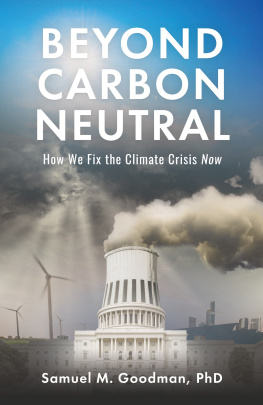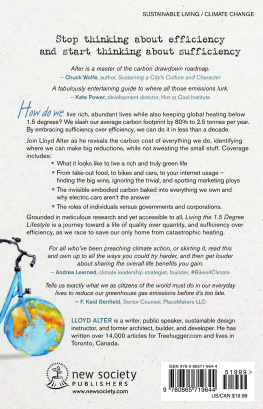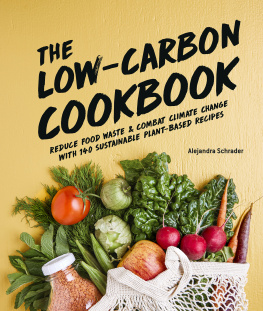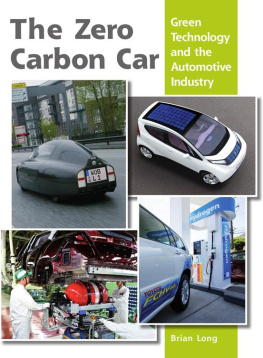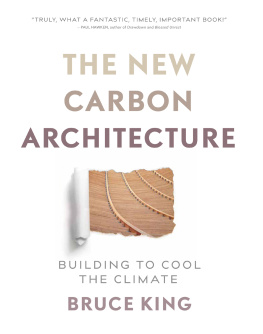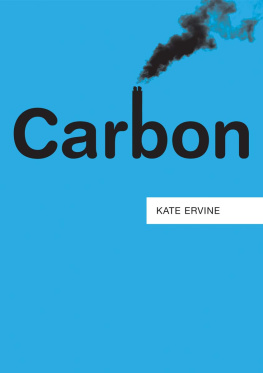How Bad Are Bananas?
MIKE BERNERS-LEE
How Bad Are Bananas?
THE CARBON FOOTPRINT OF EVERYTHING

Copyright 2011 by Mike Berners-Lee
First published in Great Britain in 2010 by Profile Books Ltd.
11 12 13 14 15 5 4 3 2 1
All rights reserved. No part of this book may be reproduced, stored in a retrieval system or transmitted, in any form or by any means, without the prior written consent of the publisher or a license from The Canadian Copyright Licensing Agency (Access Copyright). For a copyright license, visit www.accesscopyright.ca or call toll free to 1-800-893-5777.
Greystone Books
An imprint of D&M Publishers Inc.
2323 Quebec Street, Suite 201
Vancouver BC Canada V5T 4S7
www.greystonebooks.com
Cataloguing data available from Library and Archives Canada
ISBN 978-1-55365-831-3 (pbk.)
ISBN 978-1-55365-832-0 (ebook)
Cover design by Jessica Sullivan
Cover photograph by John Sherlock
Distributed in the U.S. by Publishers Group West
Contents
1 kilo to 10 kilos
(2.2 pounds to 22 pounds)
10 kilos to 100 kilos
(22 pounds to 220 pounds)
Where the numbers come from
A FEW YEARS AGO I agreed to go around a supermarket with a journalist who wanted to write an article on low-carbon food. We trailed up and down the aisles with the Dictaphone running, and she plied me with questions, most of which I was pitifully unable to answer.
What about these bananas?... How about this cheese?... Its organic. That must be better... isnt it?... Or is it?... Lettuce must be harmless, right?... Should we have come here by bus?... At least we didnt fly! How big a deal is food, anyway?
It was not at all clear what the carbon-conscious shopper should do. There was clearly a huge gap in the available consumer knowledge, and, on that day, we couldnt fill it. The article never happened, and its probably just as well. Since then I have looked long and hard into all kinds of carbon footprints and carried out numerous studies, including one for a supermarket chain.
This book is here to answer that journalists questions, and many more besides. Its not just a book about food and travel. I want to give you a sense of the carbon impactthat is, the climate change impactof everything you do and think about. I want to give you a carbon instinct. Although I have discussed the footprint of just under one hundred items, I hope by the time you have read about these you will have gained such a sense of where carbon impacts come from that you will be able to make a reasonable guesstimate of the footprint of more or less anything and everything that you come across. It wont be exact, but I hope youll at least be able to get the number of zeros right most of the time. There are messages in this book for ordinary people, some for businesses, and a few sprinkled in for policy makers too.
Some basic assumptions
Im hoping I can take three things for granted:
> climate change is a big deal;
> its caused by humans,
> and we can do something about it.
However, out of respect for the still-widespread confusion over these assumptions, I have put more about them in an appendix in case you want to check them out before moving on.
Perspective
A friend recently asked me how he should best dry his hands to reduce his carbon footprintwith a paper towel or with an electric hand drier. The same person flies across the Atlantic literally dozens of times a year. A sense of scale is required here. The flying is tens of thousands of times more important than the hand drying. So my friend was simply distracting himself from the issue. I want to help you get a feel for roughly how much carbon is at stake when you make simple choiceswhere you travel, how you get there, whether to buy something, whether to leave the TV on standby, and so on.
Picking battles
Im not trying to give you a list of 500 things you can do to help save the planet. You could probably already write that list yourself. You will find at least 500 possibilities in here, but this is a book about helping you work out where you can get the best return for your effort. This book is here to help you pick your battles. If you enjoy the read and by the end of it have thought of a few things that can improve your life while cutting a decent chunk out of your carbon, then Ill be happy. The book isnt here to tell you what to do or how radical to be. Those are personal decisions.
Is carbon like money?
In one sense, yes it is.
Carbon is just like money in that you cant manage it unless you understand it, at least in broad terms. Most of the time we know how much things cost without looking at the price tag. I dont mean that we have an exact picture, but we know that a bottle of champagne is more expensive than a cup of tea but a lot cheaper than a house. So most of us dont buy houses on a whim. Our financial sense of proportion allows us to make good choices. If I really want champagne, I know I can have it, provided that somewhere along the line I cut out something just as expensive that is less important to me. Our carbon instinct needs to be just like the one we have for managing our money.
Thats where the similarity ends. Unlike with money, we are not used to thinking about carbon costs. Its also much harder to tell how much we are spending because we cant see it and its not written down. Furthermore, unlike what happens when we spend a lot of money, we dont personally experience the consequences of our carbon impact because its spread across nearly seven billion people and many years.
Enjoy the read
These pages are written for people who want to love their lives and for whom that now entails having some carbon awareness alongside everything else that matters to them.
Dip in. Keep this book by the loo. Read it from cover to cover or flit around. Use it as a reference if you like. Talk about it. Take issue with it. Let me know how it could be improved (info@howbadarebananas.com). Think of it like an early map, full of inaccuracies but better, I hope, than what you had before.
If theres something else to be gleaned from the book, it is that nearly all of us, including me, have plenty of junk in our lives that contributes nothing at all to the quality of our existence. Its deep in our culture. Cutting that out makes everyones life better, especially our own. I got a big win by swapping my solo car commutes for bike rides and carpools. That works for me, but Im not prescribing that particular solution for you, because we are all different. I hope you enjoy the read and that, while you are at it, you bump into at least something you can use.
So how bad are bananas?
As it happens, they turn out to be a fine low-carbon food, though not totally free from sustainability issues to keep an eye onsee .
Carbon footprint is a lovely phrase that is horribly abused. I want to make my definition clear at the outset.
Throughout this book, Im using the word footprint as a metaphor for the total impact that something has.
And Im using the word carbon as shorthand for all the different global warming greenhouse gases.
So, Im using the term carbon footprint as shorthand to mean the best estimate that we can get of the full climate change impact of something. That something could be anythingan activity, an item, a lifestyle, a company, a country, or even the whole world.
CO2e? Whats that?
Human-caused climate change, also known as global warming, is caused by the release of certain types of gas into the atmosphere. The dominant greenhouse gas generated by humans is carbon dioxide (CO2), which is emitted whenever we burn fossil fuels in homes, factories, or power stations. But other greenhouse gases are also important. Methane (CH4), for example, which is emitted mainly by agriculture and landfill sites, is 25 times more potent per pound than carbon dioxide. Even more potent but emitted in smaller quantities are nitrous oxide (N2O), which is about 300 times more potent than carbon dioxide and released mainly from industrial processes and farming, and refrigerant gases, which are typically several thousand times more potent than carbon dioxide.
Next page
